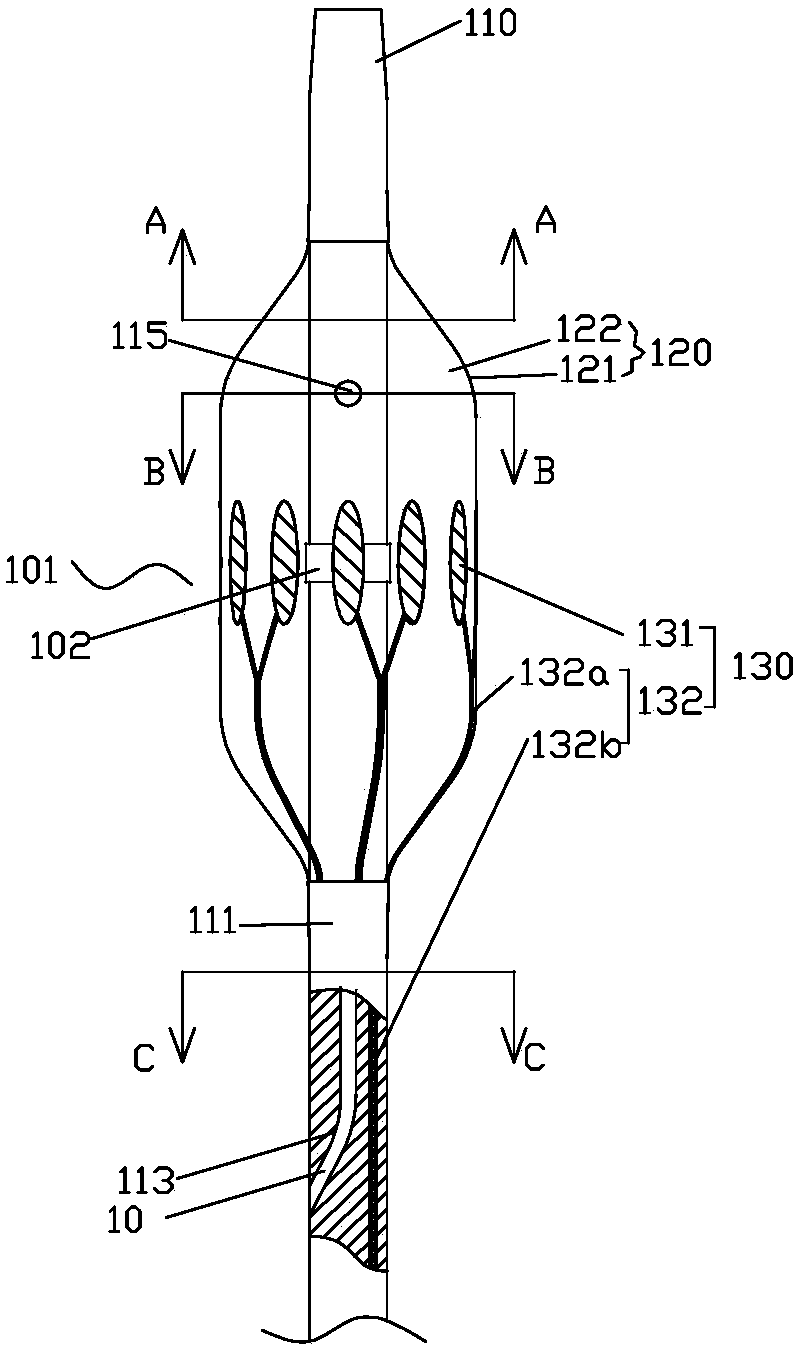Transcatheter interventional atrial septostomy device
A technique of catheter intervention and interatrial septum, which is applied in the field of medical devices, can solve problems such as heart tissue tearing and damage, and achieve the effects of controllable stoma size, avoiding embolism, and avoiding device falling off
- Summary
- Abstract
- Description
- Claims
- Application Information
AI Technical Summary
Problems solved by technology
Method used
Image
Examples
Embodiment 1
[0051] like Figure 1-4 As shown, a transcatheter atrial septostomy device includes a catheter body 110 and a radially inflatable balloon 120 fixed on the distal end of the catheter body 110; the balloon 120 is provided with a The stoma 101 expands the atrial septal tissue radially and stretches the atrial septal tissue apart. The stoma 101 is provided at least on the outer surface of the balloon 120 along a circle in the circumferential direction, and is electrically connected to the ablation power supply and the control mechanism. The electrode assembly 130 ; the catheter main body 110 is provided with a guide wire lumen 113 through both ends and a filling lumen 114 for filling the balloon 120 along the axial direction.
[0052] like Figure 1-4 As shown, the catheter body 110 is used to realize the support and delivery functions of the balloon 120. It is a tubular structure with a lumen inside it. According to different functions, the catheter body 110 is at least provided...
Embodiment 2
[0063] This embodiment is an improvement based on the first embodiment.
[0064] like Figure 5-11 As shown, a transcatheter atrial septostomy device includes a catheter body 110 and a radially inflatable balloon 120 fixed on the distal end of the catheter body 110; the balloon 120 is provided with a The stoma 101 expands the atrial septal tissue radially and stretches the atrial septal tissue apart. The stoma 101 is provided at least on the outer surface of the balloon 120 along a circle in the circumferential direction, and is electrically connected to the ablation power supply and the control mechanism. The electrode assembly 130 ; the catheter main body 110 is provided with a guide wire lumen 113 through both ends and a filling lumen 114 for filling the balloon 120 along the axial direction.
[0065] The difference from Embodiment 1 is that the balloon 120 is provided with a positioning mechanism for positioning the electrode assembly 130 relative to the atrial septal tis...
Embodiment 3
[0070] This embodiment is improved on the basis of Embodiment 1:
[0071] like Figure 12-15 As shown, a transcatheter atrial septostomy device includes a catheter body 110 and a radially inflatable balloon 120 fixed on the distal end of the catheter body 110; the balloon 120 is provided with a The stoma 101 expands the atrial septum and expands the atrial septal tissue radially. The stoma 101 is provided with electrodes electrically connected to the ablation power supply and the control mechanism at least on the outer surface of the balloon 120 along the circumference. Assembly 130 ; the catheter body 110 is axially provided with a guide wire lumen 113 through which two ends pass through and a filling lumen 114 for filling the balloon 120 .
[0072]On the outer surface of the balloon 120, three sets of electrode groups uniformly distributed along the axis are arranged, and the three sets of electrode groups are arranged in parallel in the axial direction. Each electrode gro...
PUM
 Login to View More
Login to View More Abstract
Description
Claims
Application Information
 Login to View More
Login to View More - R&D
- Intellectual Property
- Life Sciences
- Materials
- Tech Scout
- Unparalleled Data Quality
- Higher Quality Content
- 60% Fewer Hallucinations
Browse by: Latest US Patents, China's latest patents, Technical Efficacy Thesaurus, Application Domain, Technology Topic, Popular Technical Reports.
© 2025 PatSnap. All rights reserved.Legal|Privacy policy|Modern Slavery Act Transparency Statement|Sitemap|About US| Contact US: help@patsnap.com



